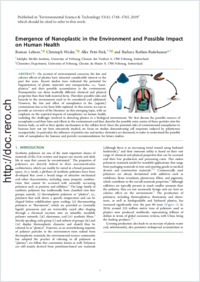Emergence of nanoplastic in the environment and possible impact on human health
- Lehner, Roman Adolphe Merkle Institute, University of Fribourg, Chemin des Verdiers 4, 1700 Fribourg, Switzerland
- Weder, Christoph Adolphe Merkle Institute, University of Fribourg, Chemin des Verdiers 4, 1700 Fribourg, Switzerland
- Petri-Fink, Alke Adolphe Merkle Institute, University of Fribourg, Chemin des Verdiers 4, 1700 Fribourg, Switzerland - Chemistry Department, University of Fribourg, Chemin du Musée 9, 1700 Fribourg, Switzerland
- Rothen-Rutishauser, Barbara Adolphe Merkle Institute, University of Fribourg, Chemin des Verdiers 4, 1700 Fribourg, Switzerland
-
19.02.2019
Published in:
- Environmental Science & Technology. - 2019, vol. 53, no. 4, p. 1748–1765
English
On account of environmental concerns, the fate and adverse effects of plastics have attracted considerable interest in the past few years. Recent studies have indicated the potential for fragmentation of plastic materials into nanoparticles, i.e., “nanoplastics,” and their possible accumulation in the environment. Nanoparticles can show markedly different chemical and physical properties than their bulk material form. Therefore possible risks and hazards to the environment need to be considered and addressed. However, the fate and effect of nanoplastics in the (aquatic) environment has so far been little explored. In this review, we aim to provide an overview of the literature on this emerging topic, with an emphasis on the reported impacts of nanoplastics on human health, including the challenges involved in detecting plastics in a biological environment. We first discuss the possible sources of nanoplastics and their fates and effects in the environment and then describe the possible entry routes of these particles into the human body, as well as their uptake mechanisms at the cellular level. Since the potential risks of environmental nanoplastics to humans have not yet been extensively studied, we focus on studies demonstrating cell responses induced by polystyrene nanoparticles. In particular, the influence of particle size and surface chemistry are discussed, in order to understand the possible risks of nanoplastics for humans and provide recommendations for future studies.
- Faculty
- Faculté des sciences et de médecine
- Department
- Département de Chimie, AMI - Bio-Nanomatériaux
- Language
-
- English
- Classification
- Biological sciences
- License
- License undefined
- Identifiers
-
- RERO DOC 324308
- DOI 10.1021/acs.est.8b05512
- Persistent URL
- https://folia.unifr.ch/unifr/documents/307595
Statistics
Document views: 95
File downloads:
- fin_ene.pdf: 2945
